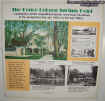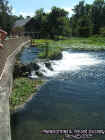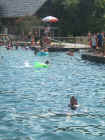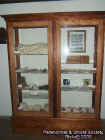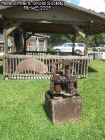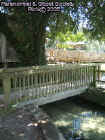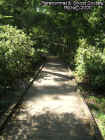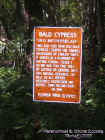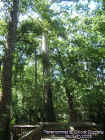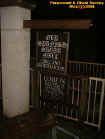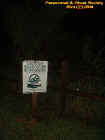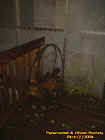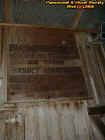|
|
||
|
|
||
|
De Leon Springs may be one of the most ancient
areas in Florida today as archaeologist have said that the land here was
inhabited by Indians as early as 8000 B.C. proof of this fact is the
oldest dugout canoe was found in America from 6,000 years ago. But what
really intrigued me perhaps is the historical facts which date back
hundreds of years ago. A time when explorers journeyed to distant lands, England's
Castles were still standing, Indians lived off the land, and plantations
were established across the southern states. With a series of rich history
and tragic events it would be no wonder as to why these 603 acres of
woods, trails and ruins are full of supernatural occurrences. But what
makes this even more special is we are one of the first paranormal
organization to dare and venture in here to investigate such sacred lands.
What is even more special is that the oldest sugar mill in the state of
Florida built in 1570 still stands today not many have an opportunity to
visit something that is 400 years old so we really feel this is a special
story we have brought you.
In the early 1500s and explorer by the name Juan Ponce De Leon traveled through the area. It is said he led some Spanish forces perhaps to clear the area for a settlement which in 1570 was the sugar mill which sugar cane was planted. De Leon noticed the springs here and called them the fountain of youth some have said. Later on this settlement was abandoned why? Reasons perhaps unknown maybe some of the colonist were spooked by the Indians surrounding it or other unknown reasons. However this area was owned by Spain till 1763 when it was Ceded by England. During England's rule they used the area as a trading post exchanging European goods to the Indians in return for furs and other necessities. A man by the name Gen. Oglethorpe named his colony Garden Springs because of the two springs that surrounded this area. However during those 20 years the colonist were massacred by the Indians. Later in the 1783 the Spanish took control again as they returned back from Spain they designated the area for the use of plantations. So for many years to follow cotton, corn, sugar cane could be cultivated. This was a time of peace there was a calm about this place as it was called the Spring Garden Plantation. In 1821 Florida was to become U.S. Territory and there were still Uchee Indians living off the land here. The springs were then visited by John James Audubon in 1822, and later in that century were promoted as a winter resort and fountain of youth. However in about 1828 Maj. Joseph Woodruff purchased about 2,020 acres surrounding the springs and started a very prosperous plantation by 1835. Today the lake that is across from the mill is named Lake Woodruff. Somehow it later became owned by Col. Orlando S. Rees. Rees had built the water wheel which was used to grind the sugar cane utilizing the springs water flowing near the mill. The Seminoles burned it down only a year later 1836 which was the first West Volusia event of the Second Seminole War (1835-42). The Seminole Indians then occupied the lands and later were forced out once again in 1838 when General Zachary Taylor of the US Florida Army had a base camp north east of the springs. It was rebuilt and expanded by Thomas Starke in about 1840 2 years after the Indians had cleared the lands. At this point the mill was in ruins but still it stood. The cost at the time for the plantation in 1840 was 50 Negro women which Wilson W. Rees received for the springs & Surrounding land. During that time once again war had plagued the area as a third Seminole War broke out in 1857-1858 a soldier involved in the war decided to remain. The area west of the lake known as Tick Island was given to them as compensation for his services later his wife Lucretia and Underhill manged many acres of groves on the island in the 1870s after the civil war. But I mention this piece of information since Tick island was near Thomas Starke's plantation. Thomas Starke ran the plantation through the civil war however. As a member of the confederacy he kept a blacksmith shop, stores, grain supplies, a superintendents house, and slave quarters here till 1864. That way soldiers had a place to rest, eat food, heal, and reinforce there weapons. However once again misfortune struck as in 1864 Union Troops invaded the DeLeon Springs area under Col. Nobel demolished everything his path except for the Spanish Sugar Mill which at the time all that was left of it was the frame, chimney, arches and its water wheel. In 1872 a man by the name George Norris purchased and rebuilt the entire area including the Sugar Mill which still was standing but in poor shape. Norris was a native of Batavia NY this does this ring a bell? Well as the owner I live for many years near Batavia before moving to Florida. By 1880 Norris planted orange groves, laid out roads, a landing pier, and even a packing house were built. Sarah Lee Fish moved here in 1882 from Indiana to grow oranges. Even a railroad depot was built at the entrance to the springs so that others could visit the springs and orange could be transported by train. Today the train tracks still remain by the entrance. Near by once again there was a settlement called Tick Island in 1879 Mack Timmons and his family moved there. A wooden house with glass windows was built. Later the settlement was sold again reasons unknown but the man who bought it never lived on Tick Island. However settlers would visit here to hunt, gather lumber, and moonshine which was very common around here. In 1889 DeLeon Springs looked promising as there were advertisements on Soda's and Sulfur. It started to become a very common spot in the later 1880s for visitors who wanted to visit the fountain of youth and enjoy its recreation here. It was a natural wonder and many settlers thought that the springs provided some form of healing so many would come from all over Florida just to bath in its clear waters. During this time it was a moment of serenity there were no more wars, massacres, or disasters. It was a nice winter retreat. In 1920 the springs could no longer serve however as a power source. The water levels began to drop and because of this so did the flow. Since at the time this was called Spring Garden Run. Bubbles began where there was less water resistance and a new spring in the area was formed. About 6 months later concrete, metal and other objects which reinforced the new spring. The original springs later were restored and began to properly flow due to this new spring which was now divided with water now flowing once again. In the 1920s as well the pavilion was later
replaced by a very large hotel. It was called the Spring Garden House and
was run by E. M. Turner. Eventually the property was surrounded by a stone
wall and the walk ways surrounding the springs were constructed.
Eventually columns were built around the spillway and the springs became a
major resort. Then during the 1930s a place called Burt's Park became a
popular attraction which had swimming, shuffle boarding, picnicking, boat
rentals for spring garden lake and run. The admission back then was a mere
10 Cents. Also at one time there was a wagon road called the Black Bear
Trail which ran near the springs all the way to Canada later it was opened
as the Dixie highway. In 1982 the state of Florida took over the springs and it is now a state park. The water no matter what time of year it is remains at a constant 72 Degrees. Visitors can see Alligators, Blue Herons, Hawks, Black Bear, Vultures, and many other types of wild life. Visitors can purchase a paddle boat or canoe and take a ride up Spring Garden Run for 3.5miles to lake Woodruff. The water from DeLeon springs flows into Spring Garden Run giving you gentle ride through wildlife as you travel through the run. Boats can explore 18,000 acres of lakes, creeks, and swamps which all surround DeLeon Springs. Many people come from all over to catch giant base in Spring Garden Run. Some just visit here to Scuba Dive in the springs themselves. While others enjoy a half of mile nature trail which twist and turn though the floodplain forest. Many others come to picnic under the large century old oak trees which cover some of the grounds. Today others can visit the Spanish Sugar Mill which has been turned into a restaurant in 1961 by Peter and Marjorie Schwarze. It is said they serve the best griddle pancakes in the county. They are made from grain stone-ground on site with French Buhr millstones with 5 different flours. Also ice-cream, sandwiches, breads, and many other treats are served here. When the restaurant is open the giant wheel turns. A tradition which has existed for the last 40 plus years here. So as you can see there is alot of history some good some bad surrounding the entire state park. But what is even more strange is the fact that the Sugar Mill withstood the battles, wars, and damages over the years. Even today much is left over such as the stone walls, giant sugar cane grinder, the sugar mill ruins, plantation ruins, and native American Indian mounds. If you hike you will find some old Indian huts which we will visit on our second investigation here. But many want to know is DeLeon Springs haunted by its past? Yes very much so people here died, Indians buried each other throughout the park, families were massacred as the Seminole wars took place, the civil war and many plantations were built and fell. It seemed like to me over the years many were scared out of here by what or whom we may never know. But just a few high points of activity here there is a apparition that is seen in the Old Spanish Sugar Mill, Shadows, Moving Cold Spots, Giant Orbs, and a Strange Mist which is surrounding the Water Wheel. Again these are just a few mentions. We will visit perhaps a second or third time to learn a little more about De Leon Springs mysteries. So take a walk with us down its dark roads into its rich history and spooks. © By Rick-AngelOfThyNight **Some of the photos are borrowed for educational use only we do not claim them to be ours only the ones which are marked as our own**
|
||
|
|
||
|
|
|




